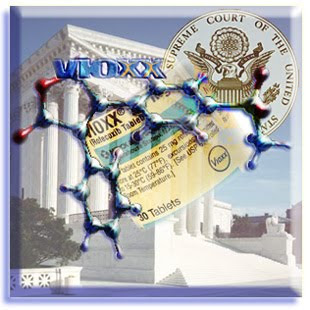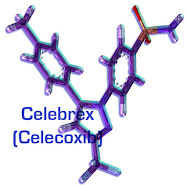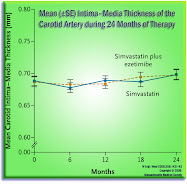 The Delaware District Court just held the Temodar® patent unenforceable. New Merck says it will appeal the trial court's decision, and seek a stay -- but Teva is now cleared, pending FDA approval, to start selling a generic version of legacy Schering-Plough's Temodar cancer drug. As I'd repeatedly noted last year, Temodar is a great drug, but it has had 32, now nearly 33, years of US patent monopoly protection. I think that's plainly more than enough, given the patent statute generally only contemplates 17 years of monopoly power for patented drugs.
The Delaware District Court just held the Temodar® patent unenforceable. New Merck says it will appeal the trial court's decision, and seek a stay -- but Teva is now cleared, pending FDA approval, to start selling a generic version of legacy Schering-Plough's Temodar cancer drug. As I'd repeatedly noted last year, Temodar is a great drug, but it has had 32, now nearly 33, years of US patent monopoly protection. I think that's plainly more than enough, given the patent statute generally only contemplates 17 years of monopoly power for patented drugs.
Per Reuters, reporting:
. . . .Teva's product has tentative marketing approval, but is awaiting final approval from the U.S. Food and Drug Administration. Once regulators clear it, the product is eligible for six months of marketing exclusivity before rival generics can go on the market, Teva said.
 "Teva's generic already has tentative approval, so it's certainly possible we will see it approved and launched within the next 48 hours," said Leerink Swann analyst Seamus Fernandez.
"Teva's generic already has tentative approval, so it's certainly possible we will see it approved and launched within the next 48 hours," said Leerink Swann analyst Seamus Fernandez.
"Once you have a district court decision, and you already have tentative approval, that releases the FDA" to take action, Fernandez said.
Teva's less-costly medicine would likely batter sales of the Merck brand and depress Merck's earnings by 4 cents to 5 cents a share this year, and for several years to come, Fernandez said.
Sanford Bernstein analyst Aaron Gal said he expects Teva to launch its product in the second quarter and for it to have no competition from another generic until the third quarter. . . .
From the very able Delaware federal District Court Judge Sue L. Robinson's opinion, just released (
Full PDF of the opinion -- 40 pages long):
. . . .The '291 patent, which issued November 9, 1993, claims priority to the filing of the '656 application through a chain of continuation applications as described below.11 The '291 patent expires in February 2014, almost thirty-two years after the first application in this chain was filed. All together, the prosecution of the '291 patent involved eleven patent applications and ten abandonments. . . .
In Symbol Technologies, Inc. v. Lemelson Medical, Education & Research Foundation, 422 F.3d 1378 (Fed. Cir. 2005), the Federal Circuit explained that there are no strict time limitations for determining whether continued refiling of patent applications is a legitimate utilization of statutory provisions or an abuse of those provisions. The matter is to be decided as a matter of equity, subject to the discretion of a district court before which the issue is raised. Id. at 1385. A court must consider "the totality of the circumstances, including the prosecution history of all of a series of related patents and overall delay in issuing claims" in determining whether laches is triggered. . . .
 It is the court's conclusion that the "ends" - commercialization of a very successful cancer drug - do not justify the "means" employed by CRCT [Schering-Plough-Merck's licensor] in this case. Taken in the totality, this case involves eleven patent applications, ten abandonments, and no substantive prosecution for a decade. CRCT's primary justification for delay, that neither Examiner Ford nor Examiner Richter would have allowed the applications at issue absent human data, is not objectively reasonable in view of the fact that CRCT never attempted to traverse the rejections (thereby either validating its position or obtaining allowance of its claims). . . .
It is the court's conclusion that the "ends" - commercialization of a very successful cancer drug - do not justify the "means" employed by CRCT [Schering-Plough-Merck's licensor] in this case. Taken in the totality, this case involves eleven patent applications, ten abandonments, and no substantive prosecution for a decade. CRCT's primary justification for delay, that neither Examiner Ford nor Examiner Richter would have allowed the applications at issue absent human data, is not objectively reasonable in view of the fact that CRCT never attempted to traverse the rejections (thereby either validating its position or obtaining allowance of its claims). . . .
For the reasons discussed above, the court finds the '291 patent unenforceable due to prosecution laches and/or inequitable conduct. . . .
The trial court did not ultimately rest its conclusion solely on laches -- or failure to prosecute the patent -- it also set out facts to suggest that Schering-Plough, now known as New Merck -- engaged in "
inequitable conduct" -- attempting to deceive the US Patent and Trademark Office.
That is a
jaw-slackingly rare occurence -- at least in big pharma cases. But, not inconsistent with what we've seen of Schering-Plough, as documented by this blog. This essentially holds that Schering attempted to
hide evidence from the PTO. And so, I suspect this ruling will stand -- on appeal.
Teva (as successor to Barr) has said it will be ready to sell in the US by Q2 2010. That's about $360 million a year -- but the global Temodar franchise is about $1 billion a year. There may now be grounds for legal proceedings, in the rest of world, on the Temodar patents -- given today's opinion. "
Blood in the water", and all that.
Ouch. Ouch! Ouch.
That "
Fast" Freddie Hassan sure sold Dick Clark a sow's ear, no?
 SeekingAlpha points to what he believes is Merck CEO Dick Clark either (i) mentioning a deal not yet done, or (ii) getting confused about a prior license deal, at a JP Morgan conference on January 12, 2010.
SeekingAlpha points to what he believes is Merck CEO Dick Clark either (i) mentioning a deal not yet done, or (ii) getting confused about a prior license deal, at a JP Morgan conference on January 12, 2010. . . . ."And as we announced the Merck (MRK) BioVenture in the last year or so, we continue to do acquisitions with Insmed and relationships with Insmed and Avecia for a biological standpoint to build our infrastructure and manufacturing capabilities. So I think this will be an important part of our strategy. It’s not put on the back burner as some have suggested that would take place."

































 headwinds, is bullish on health insurance stocks, like UnitedHealth, Aetna and WellCare. But he's steering clear of drug makers like Pfizer and Merck. (He recommends sub-sectors, not individual companies). . . .
headwinds, is bullish on health insurance stocks, like UnitedHealth, Aetna and WellCare. But he's steering clear of drug makers like Pfizer and Merck. (He recommends sub-sectors, not individual companies). . . .

























